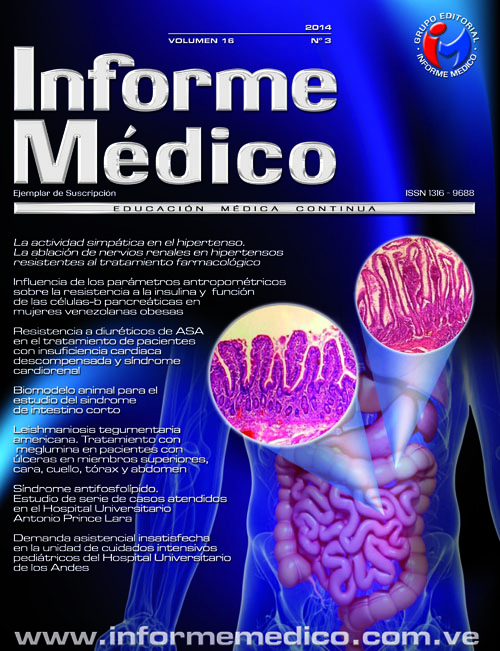Leishmaniosis Tegumentaria Americana. Tratamiento con Meglumina en Pacientes con Úlceras en Miembros Superiores, Cara, Cuello, Tórax y Abdomen
Palabras clave:
Leishmaniosis tegumentaria americana, Antimoniales pentavalentes, American tegumentary leishmaniasis, Meglumine antimoniateResumen
El tratamiento de la leishmaniosis tegumentaria americana (LTA), endemia parasitaria persistente en el medio rural venezolano, debe ser actualizada periódicamente. El antimoniato de meglumina (AM) como medicamento de elección se emplea en la Consulta de Endemias Rurales de Medicina Tropical a una dosis menor a la recomendada por la Cátedra de Medicina Tropical, cuando los pacientes acuden con úlceras por la enfermedad en cara, cuello, tórax, abdomen y miembros superiores. Se evalúa la experiencia en los últimos ocho años. Se practicó el diagnóstico integral a estos pacientes (diagnóstico presuntivo + diagnóstico de certeza) y se les administró 3.000 mg/día de meglumina en series terapéuticas de 10 días y de 4.500 mg/día de ser necesario, de manera ambulatoria. Concluyeron el estudio 91 pacientes: 57 (63%) del género masculino y 37% del femenino con edad promedio de 42 años; el 75% procedia del estado Miranda; de ocupación agricultores 22%, comerciantes y obreros 21%, artesanos 18%, oficios del hogar 17% y viajeros 22%. De ellos, 90 fueron tratados ambulatoriamente. Uno fue hospitalizado en el Servicio de Enfermedades Infecciosas del Adulto del Hospital niversitario de Caracas, por la edad y la úlcera en el pabellón auricular. El 14% eran viajeros y el 27% recibió cefadroxilo previo al uso de AM, para control de infección bacteriana sobreagregada. Del total de pacientes, 84 (94%) recibió dos series de AM de 3.000 mg/día, 3 pacientes recibieron una serie de 3.000 mg/día y 2 pacientes recibieron dos series de 4.500 mg/día. Todos evolucionaron satisfactoriamente con cicatrización adecuada de las úlceras. Se evidenció recaida en dos pacientes y se repitió el tratamiento con AM con evolución adecuada. Se demuestra que las series terapéuticas de AM a 3.000 mg/día, por 10 días, y cuando es necesaria, la dosis de 4.500 mg/día, resuelven satisfactoriamente el problema ulceroso en LTA. Cuando las lesiones son en miembros superiores, cuello, cabeza, tórax, cara y abdomen, a diferencia de las úlceras leishmánicas en miembros inferiores, requieren mayores dosis y el recurso de la hospitalización para lograr la reepitelización tisular.Abstract
AMERICAN CUTANEOUS LEISHMANIOSIS. TREATMENT WITH MEGLUMINE IN PATIENTS WITH ULCERS IN UPPER LIMBS, FACE, NECK, THORAX AND ABDOMEN
American cutaneous leishmaniasis (ATL) treatment, an endemic parasitic disease, in rural Venezuelan areas, should be periodically revised. Meglumine antimoniate (MA) is the drug of choice used for the treatment of patients consulting at the Endemic Rural Diseases Medical Clinic, showing ulcers in face, neck, chest, abdomen and upper limbs, at doses lower than the recommended ones by the Tropical Medicine Department. We evaluated the treatment of these kind of lesions during the last eight years; after assessment of patients to reach the final diagnosis (presumptive and confirmatory diagnosis). Patients received treatment with 3000 mg/day of meglumine antimoniate in 10 day series; and when required, a higher 4500 mg/day dose, always as outpatients. The trial was concluded by 91 patients: 57 (63%) were men and 37% women with a mean age of 42 years; 75% came from the Miranda State; occupation of patients were: agriculture 22%, merchants and labourers 21%, artisans 18%, household 17% and travellers 22%. Of the 91 patients, 90 were treated as outpatients and only one was hospitalised at the University Hospital of Caracas (Adult Infectious Diseases ward) because of advanced age and ulcer in the ear; 27% received cefadroxil to treat a bacterial infection of the ulcer, previously to meglumine administration; 84 (94%) received two MA courses of 3000 mg/day, three patients received one course of 3000 mg/day and 2 patients received two courses of 4500 mg/day. All patients had successful outcomes and adequate ulcers healing. Relapse was observed in two patients and MA treatment was repeated with good outcomes. These results demonstrate that meglumine at 3000 mg/day during 10 days dose, and when necessary at 4500 mg/day dosage, heals satisfactorily the ulcers produced by ATL when they are located in upper limbs, neck, head, trunk, face and abdomen; a different approach for those located at the lower limbs that requiere higher AM dosage and sometimes hospitalization to reach proper ulcer healing.
Descargas
Los datos de descargas todavía no están disponibles.

